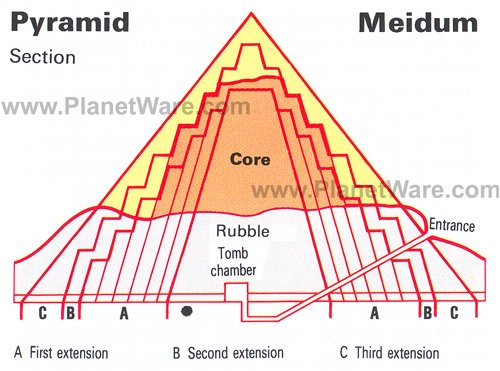Page 4 of 4
Posted: Thu Dec 18, 2008 7:14 pm
by dannan14
Min, could you clarify something for me. i've heard several people talk about the idea of using the ramp to build the outside of the pyramid from the top down, but i haven't been able to visualize how that would work.
Posted: Thu Dec 18, 2008 9:50 pm
by Minimalist
If you look at thepicture of the Meidum "pyramid" you see that Sneferu actually completed the central core of the pyramid.
I found this chart elsewhere:

Once you have the core built then you can start to push out towards the sides. The architects can check and correct their angles as they work downward. But, as Digit says, there is no way in hell they built the Great Pyramid in 20 years. Meidum is only 92 meters high ...something under 300 feet. Making it about 60 percent the size of the GP.
Posted: Thu Dec 18, 2008 10:31 pm
by dannan14
i must be missing something obvious. When i read 'top-down' i am interpreting that to mean that somehow the stones at the top are placed before the ones directly below them. That definitely makes no sense unless they forgot to pay the gravity bill.
So, judging from the diagram i have to assume that somehow 'top-down' means the stepped layers were built from the ground up and only the final shell started at the top. Or am i still completely missing the idea?
Sidenote, the core seems to have a much steeper angle than the finished product. Many of the Nubian pyramids seem to be very steep as well. Was their architecture just completely different? or did they perhaps observe the building of the core of an Egyptian pyramid and assume that was the end result?
Posted: Thu Dec 18, 2008 10:55 pm
by Minimalist

Um...yeah. The core is built in the traditional bottom-to-top method and then the sides are pushed out on the way down. The casing stones give it the pyramid shape.
I haven't paid much attention to the Nubian pyramids but the effect of the steeper sides would be to reduce the base, thus making the pyramid cheaper to build. Of course, Giza existed to provide a model also.
